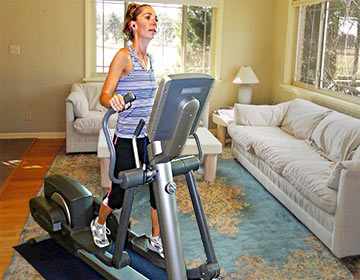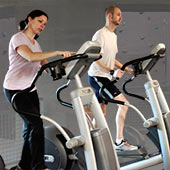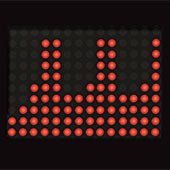Buyer's Guide to Elliptical Trainers
 Do you need an outstanding aerobic exercise machine for your home? Are you looking for an important weight-bearing exercise for your bones, but want to avoid impact? And do you want a machine you can use every day to efficiently burn through calories and fat?
Do you need an outstanding aerobic exercise machine for your home? Are you looking for an important weight-bearing exercise for your bones, but want to avoid impact? And do you want a machine you can use every day to efficiently burn through calories and fat?
If you answered yes to any or all of these questions, you’re ready for a high-quality elliptical trainer.
Elliptical trainers allow you to perform a standing exercise that offers a large, elliptical range of motion similar to walking, running or stair climbing, but without any impact. You'll find elliptical trainers featuring moving handles for your upper body, exclusively lower-body motion, adjustable incline, adjustable stride length and more.
A common characteristic with high-quality elliptical trainers is a relatively low perceived exertion, which usually means that the elliptical motion is so smooth that the workout feels easier than the true intensity would normally dictate. Many users find that these mentally easier workouts encourage them to exercise longer, and combined with the positive results, this helps them work out more consistently.
You Have Plenty of Choices in Elliptical Trainers
Now is a great time to shop for a new elliptical for your home. These days, manufacturers are offering a wide range of user-friendly elliptical trainers in varying price points with varying features and different motions, all designed to offer you a high-quality elliptical with the features you want and need.
So that you're not overwhelmed with all the choices available, this comprehensive guide walks you through all aspects of elliptical trainers and helps you determine which features are important to you, and which you can live without. You may be looking for an adjustable-stride elliptical with extra stability, while someone else is looking for a machine with incline and extensive console programming options.
After you determine what qualities and features are important to you in an elliptical trainer, you just have to try those ellipticals that meet your criteria, and choose the model that feels the best.
A Few Questions
Before you visit our shop, ask yourself a few questions so that you’re better prepared to make this important decision and find your ideal elliptical trainer:
- Who will be using your elliptical?
- How will your elliptical be used (walking, jogging or running pace)?
- How often will your elliptical be used (daily, seasonally, year-round)?
- What are your (and other users’) goals?
- Where will you put your elliptical?
Also keep in mind your exercise history, the reason you’re buying the elliptical and the goals you hope to accomplish. If you’ve previously used elliptical trainers or other cardio machines, consider what features you’ve enjoyed before, such as moving arms, incline, workout programs and heart-rate monitoring. And, consider that the commercial elliptical machine you may have used in a health club or recreation center is likely priced from $6,000 to $10,000. While it’s unrealistic to expect the identical elliptical experience for only a fraction of the cost, you can find a great number of high-quality, home elliptical trainers that will deliver a similar experience.
And, if you’re new to ellipticals, beware falling into the common trap of buying a cheap elliptical just to see if you’ll use it. The problem here is that you’d be setting yourself up for failure with an uncomfortable, unstable and noisy elliptical that will disappoint you with every stride. As you’re more likely to repeat a good experience than a bad one, stick with an elliptical that’s more likely to feel comfortable and deliver a positive outcome.
When deciding on your new elliptical machine, you should take into account who will be using it now and in the future. Initially, you may be the primary or only user. But, a high-quality elliptical will serve you well for many years to come. You might have young children now that will find athletic or fitness benefits from the elliptical as they grow older. And, your healthy behavior may inspire others to begin working out on the elliptical trainer.
The Feel
How an elliptical trainer’s motion feels is crucial to your buying decision. The shape, or pattern, of the elliptical motion varies between manufacturers, and even between models from the same manufacturers. One machine may exhibit a very flat elliptical motion, while another features significant vertical travel.
What makes this part of the decision more difficult is that what feels smooth and comfortable to one person may not feel the same to another. The machine may be well built and super reliable, but if you don’t like how it feels, you’re not going to use it much. The good news is that there’s a greater selection of high-quality ellipticals now than ever before, so you’re sure to find an elliptical that works for you and your whole household.
The shape and feel of an elliptical trainer’s motion is greatly affected by the drive axle’s location; either front drive, center drive or rear drive. Rear- and front-drive ellipticals were the only options for years, while center-drive ellipticals are a relatively recent design. You can find examples of high-quality ellipticals within each drive category. When considering a new home elliptical trainer, think back to which elliptical trainers you’ve used in the past. You may find that you prefer one drive category over the others, which may help narrow your search.
The feel of an elliptical trainer may change based on how it’s being used, so make sure you’re comfortable with the following:
- Direction of motion (forward and reverse)
- Varied resistance levels
- With moving handles (if applicable)
- Without moving handles (either holding fixed handles or swinging your arms)
- Varied incline levels (if applicable)
- Varied stride lengths (if applicable)
Stride Length (Fixed and Adjustable)
Just as the shape of the elliptical motion varies, the stride length is different from one elliptical trainer to another as well. And again, just knowing the stride length usually isn’t enough. You have to try the machine to decide what feels comfortable. A longer stride is often preferred; especially by taller users, runners and those with longer walking strides. The problem with too short of a stride is that you’ll be forced to keep a very high cadence to maintain effective workout intensity.
An increasing number of high-quality elliptical trainers boast an adjustable stride length. This feature is especially helpful for taller users, very short users, runners and anyone who enjoys a shorter or longer stride than normal. Some elliptical machines allow you to make this adjustment electronically while using the machine, while others require you to step off the machine to make a manual adjustment. If a manufacturer offers models with and without an adjustable stride, make sure each potential user tests out each variety, as there’s a chance that the non-adjustable model may feature the stride length you would always choose anyway and puchasing that model could save you some money.
Pedals and Pedal Spacing
As the pedals are your primary points of contact with an elliptical trainer, make sure they’re comfortable! You should look for pedals that provide a non-slip surface and plenty of room for your shoes. And check out the feel of the pedal angle for comfort. Several elliptical machines sport pedal cushioning to provide comfort to your feet, further reduce any stress to your joints and potentially eliminate any toe numbness that may occur. Some elliptical machines even boast angle-adjustable pedals to make sure you’re positioned properly.
The space between elliptical pedals, or Q-factor, varies from one elliptical trainer to another, and with that variance comes ergonomic concerns. Generally, closer pedal spacing that allows you to better replicate the hip and knee positioning found when walking or running is preferred, especially among women and shorter users. Your hips should remain level throughout the elliptical motion and you should avoid any machines that require your hips to shift from side to side. And again, make sure the pedal spacing feels comfortable and natural.
Resistance
Most high-quality elliptical trainers apply adjustable resistance to the elliptical motion by increasing or decreasing a magnetic or electrical load on the machine’s flywheel. The most durable, smoothest and quietest of these systems are eddy-current brakes and alternators, as neither system uses motors, friction or moving parts (other than the spinning flywheel). Eddy-current braking varies the magnetic resistance applied to the flywheel by varying the electrical current sent to the magnet. Alternator systems also use varying levels of electrical load, and this time it’s applied through a durable alternator (like you find in most cars). Some alternators are self-power generated, meaning that the elliptical user powers the machine’s alternator (and console) by striding on the machine.
Other good elliptical machines use a motor to adjust a magnet’s distance to the flywheel, while still other high-quality ellipticals require the user to manually adjust a magnet’s position with a knob that connects to the magnet with a cable. These two systems are less durable due to the moving parts, but still provide smooth, quiet resistance.
High-quality elliptical machines often offer 16, 20 or more levels of resistance. Many people think that if they’re new to elliptical machines, they won’t need that many resistance levels. The opposite is actually true. While very few people will exercise at the highest resistance level on their elliptical trainer, a greater number of resistance levels provides an improved ability to fine-tune the resistance to match your fitness level. When you have 12 or fewer resistance levels, you’re much more likely to be stuck exercising at a level that’s too easy or too difficult.
Durability, Stability and Frame Construction
An elliptical machine must be strong and stable enough to support your full weight as you stride through every workout. So durability and stability should always be among the key criteria when selecting a new elliptical trainer. Durable ellipticals include:
- Smooth, quiet resistance mechanisms with minimal moving parts (generally eddy-current brakes or alternators)
- Smooth, quiet, non-slipping belts (usually a Poly-V belt)
- A sturdy frame constructed of steel, or a combination of steel and aluminum
- Long-lasting points of contact (foot pedals and any grips or padding on the handles)
Stable elliptical trainers will feel solid underneath you and won’t rock from side to side during easy or vigorous workouts. In general, it’s best to avoid smaller, lightweight ellipticals. You should especially focus on attaining the most durability and stability your dollar can buy if your elliptical will be used by:
- Heavier users
- Multiple users
- Daily or consistent users
- Athletes, runners or anyone performing up-tempo workouts
- Users performing long workouts (one hour or more)
Upper Body
While some high-quality ellipticals only provide exercise for the lower body, a large number of good elliptical machines include moving handles that work in unison with the pedals to provide a full-body exercise. The key is to actively push and pull the arm handles along with the lower body; sharing the exercise and not just letting your upper body go along for the ride. In recruiting more muscles to help, the entire workout level increases, improving the aerobic benefits and calorie-burning power of the workout while maintaining a relatively low perceived exertion.
Just as with the stride, you’ll want to make sure the moving handles are comfortable to use. Do they force you to over-reach? Or, is the arm movement too short? Are you able to stand upright while pushing and pulling the handles, or are you forced to lean forward? Are the hand positions comfortable for you? Do the moving handles get in your way while accessing the console during the workout? Other convenient features to watch for on the moving handles of certain high-quality ellipticals include:
- Contact heart-rate sensors
- Resistance controls
- Stride-length controls
- Incline controls
It’s also important to note that another effective upper-body option is swinging your arms as you would while walking or running. This arm swing can be performed on models without moving handles, on certain models with moving handles that don’t interfere, and on models with moving handles that feature a lock-out function. While this arm swing isn’t tied into resistance, this natural motion involves the muscles of your upper body, incorporate more core stabilization and balance into your workout, and drives your legs to a quicker pace.
Incline  A number of versatile, high-quality elliptical machines allow you to vary the incline to change the elliptical motion’s shape and enhance your workout. With treadmills, a higher incline results in greater difficulty. But, different inclines on an elliptical trainer usually shift the focus of the muscular work from one part of the legs to another and can alter the stride length as well. Depending on the machine and the range of incline offered, you may be able to target your calves, gluteals, quadriceps, hamstrings or a combination of one or more of these lower-body muscle groups.
A number of versatile, high-quality elliptical machines allow you to vary the incline to change the elliptical motion’s shape and enhance your workout. With treadmills, a higher incline results in greater difficulty. But, different inclines on an elliptical trainer usually shift the focus of the muscular work from one part of the legs to another and can alter the stride length as well. Depending on the machine and the range of incline offered, you may be able to target your calves, gluteals, quadriceps, hamstrings or a combination of one or more of these lower-body muscle groups.
Some high-quality elliptical machines let you adjust incline at any time with electronic controls on the console or moving handles, while others require you to step off the machine to make a manual adjustment. An adjustable incline can add physical and mental variety to your workout, and help you find a more comfortable stride, focus on strengthening your knees, and prepare for climbing-specific goals, such as hiking or trail running.
Console Display and Controls
When checking out different elliptical consoles, your preliminary goal should be finding a user-friendly interface and satisfactory workout feedback. Many elliptical users aren’t satisfied without a workout profile, while others prefer a constant readout of calories burned or calories per hour. Most exercisers are driven by a goal of some kind, and if there's a piece of workout data that helps drive you towards your goal, make sure that crucial feedback is included on your new elliptical trainer’s console.
The layout and functionality of an elliptical's controls can affect how much you'll enjoy your workout. Make sure that you're comfortable with the resistance controls (plus incline and/or stride-length controls, if applicable), as you'll use these buttons the most during your workout. Some ellipticals even come equipped with workout controls mounted on the moving handlebars.
More and more elliptical consoles are equipped with additional features designed to enhance the user experience, including:
- Built-in reading racks to allow users to catch up on their reading and pass the time while exercising
- Integrated fans to keep users cool, make the workout more enjoyable and potentially lengthen workout time
- Varying levels of iPod/MP3 compatibility or connectivity that provide audio and/or video entertainment to motivate, help workouts fly by, and maintain training intensity
Heart Rate
Heart-rate monitors are included on many ellipticals for the purposes of tracking your workout intensity. You can exercise at a heart rate (or heart-rate range) specifically chosen to maximize efficiency for a variety of goal-based workouts, including:
- Burning calories and fat
- Following a personal fitness plan
- Exercising safely per a physician's prescription or recommendation
- Improving your sport-specific fitness
- Building endurance for cardiovascular health
- Recovering from a previous workout
Elliptical trainers monitor your heart rate through contact hand sensors and/or wireless telemetry straps. Here's a quick breakdown of how and why each system is used:
| Contact Hand Sensors | Wireless Telemetry Straps |
Contact heart-rate monitoring uses hand sensors usually found on the stationary or moving handles. After gripping the hand sensors for several seconds, your heart rate will be displayed on the console. If you just want to periodically check your heart rate, or don't prefer to wear a heart-rate strap, an elliptical that features contact heart rate may be of interest to you. | A telemetry heart-rate system provides the most accurate monitoring. It utilizes an adjustable, wireless strap worn around your chest that picks up an electrical impulse from your heart and sends a radio frequency signal to the console. This hands-free system allows a constant heart-rate readout on the console, making it especially useful when performing the built-in, interactive, heart-rate control programs available on many ellipticals. These programs use automatic resistance adjustments to maintain or vary your heart rate. The most common heart-rate control programs are designed to either maximize fat burning or improve cardiovascular fitness. |
Stand-alone heart-rate monitors are also available, offering you the ability to accurately monitor your heart rate on an elliptical machine (or any fitness equipment) without built-in heart-rate monitoring, or while exercising outdoors.
Console Programming
Elliptical trainer programming can take a repetitive aerobic exercise and transform it into a dynamic, challenging hill session, an invigorating interval session or a scientifically based, heart-rate control program. Depending on the elliptical trainer, built-in programs automatically adjust resistance, incline and/or stride length to deliver a variety of courses or workouts. Popular program choices include:
- Random
- Intervals
- Hills
- Heart-rate control
- Preset distance courses
- Goal-based
- Fitness tests
- User-defined (custom) courses
If you’ve had success using a specific elliptical program at the gym, chances are you’ll be able to find a similar program on an elliptical for your home. Many exercisers will just hop on the elliptical trainer at the gym and press the quick start button for a manually controlled workout. But after your elliptical machine is assembled, you'll have time to read the owner's manual, explore the programming options and learn how a key program can keep you motivated and enhance your entire fitness regimen. Plus, many elliptical manufacturers make it easier than ever to use workout programs by incorporating a user ID function. Depending on the elliptical trainer, a user ID may let you:
- Store personal data (age, weight, etc.) for a quick, user-specific start to workout programs
- Store workout data, allowing you to track your workout totals, progress, and even personal bests
- Memorize workouts, letting you repeat (or even compete against) previous favorite workouts
The Fun Part: The Test Drive!
Okay. You should now have a better idea of what’s important when shopping for an elliptical trainer. Now it’s time for the test drive! We highly recommend you (and anyone else who will be using the elliptical) try out any elliptical in the specific manner you’ll use it in your home. Doing anything less will provide you with limited feedback and potential disappointment. Here are some tips and questions for you:
- Bring whatever shoes you’ll be wearing while exercising at home.
- Make sure you’re comfortable stepping on and off the elliptical machine (it may feel a little awkward at first if you’re new to ellipticals). Some elliptical trainers boast low step-up heights to make getting on and off the machine easier.
- When you’re testing an elliptical trainer, be sure you turn on the machine and adjust the resistance to a level you’d use during a workout. How an elliptical feels while just spinning freely isn’t nearly as important as how it feels while the resistance is activated.
- Spend enough time to see how an elliptical feels and sounds when you exercise at various paces, and while moving forward and backward. And, when applicable, check out how it feels at different angles, with different stride lengths, and with or without the moving arm handles.
- Do the pedals feel comfortable? Do they fit your feet? Does the pedal spacing feel comfortable for your knees and hips?
- Are you comfortable with the feel of the elliptical motion, the length of the stride and the vertical travel of each stride?
- If the elliptical trainer features moving handlebars, are you comfortable with the upper-body motion?
- Does the elliptical feel sturdy and stable while you’re using it?
- Are the elliptical controls easy to use while exercising?
- Is the key workout statistic you’re interested in constantly displayed or only shown periodically as the console display scans?
- If reading during your workout is important to you, bring along a few of your favorite magazines to test out the reading rack.
- Will the elliptical machine fit where you want to put it in your home? Bring a tape measure, and be sure to determine your head height at its peak position.
Mats or Flooring
When setting up an elliptical in your home, we strongly recommend placing it on an equipment mat or rubberized flooring for the following reasons:
- It helps prevent static electricity issues from affecting the elliptical trainer or user.
- It keeps your elliptical trainer clean and prevents dirt, dust, pet hair, carpet fiber or other debris from causing any wear and tear on mechanical or electrical parts (it's important to note that you should periodically vacuum the mat surface and surrounding area).
- It protects your home’s flooring from the elliptical machine and keeps your elliptical from shifting.
- It helps insulate any noise from the elliptical.
Thanks for reading. We look forward to helping you make this important step on the road to improved health and fitness!
